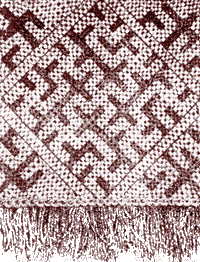Karelian Embroidery
|
||
 Embroidery has a centuries-old history in traditions of Karelian and Veps people but the most ancient samples that reached our time are dated not earlier than 1200 AD.
Embroidery has a centuries-old history in traditions of Karelian and Veps people but the most ancient samples that reached our time are dated not earlier than 1200 AD.
Initially patterns had the magical meaning and were embroidered by copper-bronze spiral wire on woolen fabric. Later on the magical flavor was lost and the embroideries begun to be made by usual silk and cotton strings on simple linen fabric. Till the beginning of 20-th century, in the conditions of patriarchal economy, embroidery was a mass occupation and was mandatory skill of each woman.
Embroidered cloths and linen were the integral attributes of the wedding, burial and funeral repast rituals. Karelian embroidery is characteristic by laconic geometrical patterns (traditions say that they prevent from witchcraft). Vegetative and animal motives are also quite schematic. Rather often one may meet the images of such fantastic creatures as tree-man, animal-bird, two-headed horse. Al this says about exclusively ancient, archaic nature of the art. The main color composition in Karelian and Veps embroidery is a red-white pair. The Northern Karelian embroidery used mainly geometrical patterns. The almost full lack of animalistic patters is characteristic for Veps embroidery. Both nations used quite similar compositions. By their semantic and magic meanings the Karelian patterns can be compared with petroglifs (figures on crags) created by far ancestors of Karelian and Veps peoples. |
